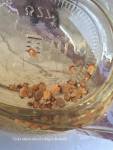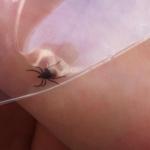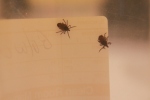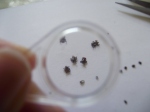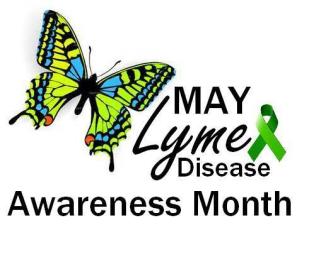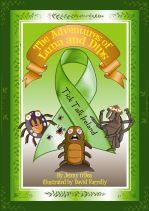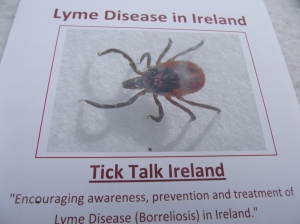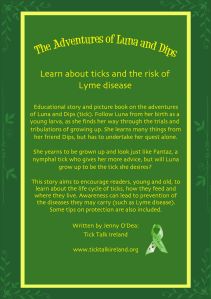
I was reading with great interest the reports from a Lyme Disease Taskforce in Pennsylvania America. Why the focus on America I hear you ask? Well, strangely for years the treatment & diagnosis of Lyme Disease has been led by the US CDC (Centre for Disease Control) & the IDSA (Infectious Disease Society of America). Both groups feel that Lyme is easily tested & easily treated – so why are patients finding themselves repeatedly testing negative & why is treatment often not making a difference to their symptoms?
First of all Lyme can be tricky to diagnose – the symptoms are not specific to the illness but there are clues, for instance feeling fluey is a symptom many of us get from time to time but summer time flu is a concern & may suggest a Lyme infection.
Following an insect bite (ticks are not insects but arachnids but have mentioned insects to inc mosquitoes, gnat bites etc) a rash is common ie you may have reddening, irritation or welting & swelling, in Lyme however it most usually doesn’t itch or welt & the rash usually starts to expand from the centre – it may then begin to form rings like a dartboard however be aware that sometimes it can be uniform in nature (ie no rings) & sometimes may expand into shapes that are not circular.
Some patients even miss stage one of the disease (ie no rash or flu) & skip to later stages which have crossover to other illnesses – they can resemble for example ME/CFS, MS, arthritis, depression & much much more. Our links section contains a lot of studies on other crossover infections.
So if a patient doesn’t get an obvious bulls-eye rash (which is diagnostic) then the physician has to rely on testing & this is where problems occur.
In our surveys we found that 64 out of 104 respondents (61%) were diagnosed through the HSE or NHS using Elisa or Western Blot testing. However 48 respondents (46%) chose to use private labs. in Germany or America to support their diagnosis (some using both private & public).

Reasons for using a private lab. can be down to several factors – the antibody Elisa test is not always effective in detecting borrelia infection in early cases and in some manifestations of late disease, so if your doctor tested you at a time where your antibodies were negative you would have been told that you don’t have Lyme disease. Private labs may use antigenic/ T cell testing methods as opposed to the 2 tier antibody test, and are often equipped to test for other tick borne diseases which may be in addition to the Lyme infection. Examples include bartonella, ehrlichia (anaplasma), babesia, mycoplasma and Chlamydia pneumonaie.
For an in depth look at testing see our page at https://ticktalkireland.wordpress.com/lyme-links/testing/
or for a summarised look at testing concerns go to: https://ticktalkireland.files.wordpress.com/2015/04/issues-surrounding-testing.pdf
More on tick-borne co-infections can be found at: https://ticktalkireland.wordpress.com/lyme-links/co-infections/
When a patient does get the diagnosis & everything fits clinically then along comes the next hurdle – treatment! The IDSA feel that a few weeks antibiotics will clear a Lyme infection & any ongoing symptoms are nothing to do with the disease itself. I agree that in some cases permanent damage does occur & in other cases the symptoms may be ongoing due to a different infection (for example a co-infection often requires different treatment so if this is not addressed it will hamper recovery from Lyme disease).
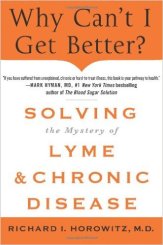 As Dr Horowitz says in his book if you have 16 nails in your foot & you pull out 3 of them your still going to be hurting! However, due to the idea that Lyme is so easy to treat this often leads to disbelief when the patient presents with ongoing symptoms or develops new ones & often they are told their illness is of mental origin (in our survey in terms of misdiagnosis 32 out of 104 indicated they were previously diagnosed with chronic fatigue syndrome (not surprising when the most reported symptoms is profound fatigue & weakness) & 18 people were told they had a psychiatric illness.
As Dr Horowitz says in his book if you have 16 nails in your foot & you pull out 3 of them your still going to be hurting! However, due to the idea that Lyme is so easy to treat this often leads to disbelief when the patient presents with ongoing symptoms or develops new ones & often they are told their illness is of mental origin (in our survey in terms of misdiagnosis 32 out of 104 indicated they were previously diagnosed with chronic fatigue syndrome (not surprising when the most reported symptoms is profound fatigue & weakness) & 18 people were told they had a psychiatric illness.
Meanwhile, the opposing group ILADS (International Lyme & Associated Diseases Society) realise that testing can be hit or miss, patients can remain ill for long periods of time & they consider co-infections plus persistence of infection & look at ways to help the patient with regards to lifestyle & dietary change, the use of supplements & so on. They realise there is no one size fits all form of treatment. Again the doctors, patients (& groups) who use ILADS philosophy are ridiculed by certain members of the IDSA & a Lyme Ad Hoc Committee Group was purportedly set up especially for this purpose.
In this document we have covered some of the studies written by IDSA guideline authors themselves that discredits their own current view… Meanwhile our section on chronic lyme has a lot of food of thought for those willing to get their teeth into it… or maybe this patents list is an eye opener?
In our prev blog post we covered some advances being made – let’s hope this will continue & we can bridge the gap between IDSA & ILADS into which many a patient falls!
Meanwhile some urine tests are being developed which could be useful for early Lyme & we await advances in those, plus the Hilysens test has now moved into stage 2 of its development.
So back to the taskforce in America, after reading the report I was keen to ask for an update on the taskforce that was taking place here in Ireland. Despite the Irish taskforce meeting being held early May we have had no feedback at all & we were promised a few times by Minister of Health Leo that a patient representative would be invited & yet no-one in our team was ever approached to take part. I sent this message below to the Dublin Health Protection Office in Oct 2015 & currently awaiting a reply… Letter to Dr Paul Mckeown
Plus our letters in the past
Letter of Concern, Letter to the IDSI et al, Letter following consensus document, The Big Lyme Debate, Minutes from meeting with HPSC, ..
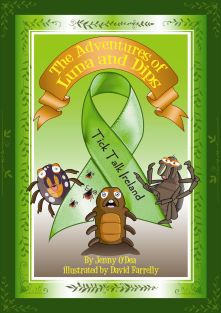
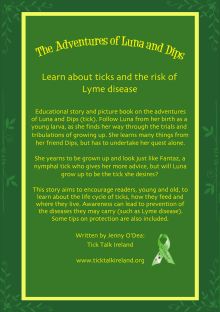
Luna Tick is looking for readers!
Developed by Jenny O’Dea from Tick Talk Ireland the Adventures of Luna & Dips was initially released for school children across Ireland. In 2013 schools also received a teacher’s pack complete with poster, leaflets, colouring sheets (Luna to colour, Fantaz to colour & Dips to colour) + useful information. We also sent copies complete with poster & leaflets to some public librairies.
Now Luna has been released in kindle version & available WORLDWIDE in all kindle stores! Suited to ages 10 & up (inc adults) & beautifully illustrated by Dave Farrelly.
At just 1.50 (UK pounds) this is reasonably priced & all proceeds go towards keeping our website going! PS: Those without kindle can download an app via amazon to read on their phone, laptop, PC..

Is Lyme the new Aids?
There’s often been a comparison to the patient movement & the plight of many in Aids. Dr Jemsek who previously worked with Aids patients prior to becoming a Lyme specialist says that Lyme patients are often sicker & more difficult to treat.
Meanwhile in an article by Jessica Bernstein (Doctor of Psychology) she states that Dr. Conant was one of the first physicians to identify AIDS in 1981 & he says there are striking parallels between the struggle faced by AIDS patients and the battle being waged by those suffering with Lyme today. He points out that Lyme research only receives $25 million a year in funding, while many of the other infectious diseases receive between $100 and $200 million annually. HIV now receives over $3 billion a year. This article by Bernstein is a very interesting insight into Dr Conant’s views.. http://www.truth-out.org/news/item/21206-from-aids-to-lyme-will-we-let-history-repeat-itself
Another focus on HIV v Lyme is in this 3 part Huffington post series ‘Is Lyme Disease the New AIDS? What You Need to Know‘.
Part 2 available here. 3rd & final instalment here.
So what can we learn from this post? We can learn that testing & treatment simply is NOT a one size fits all approach to Lyme, there are many challenges faced by doctors & patients alike. The recent debate in the House of Lords UK showed some of the problems that can occur. Lyme Disease Action has links to the video plus transcripts covering the proceedings. In Ireland too there have been hearings held by patients plus a UK parliamentary hearing.
Meanwhile we note with interest that the other side of the world is also hitting problems with regard to testing & treatment, a quote from the Chief Medical Officer Chris Baggoley in Australia came to light recently, he was quoted as saying “There’s no reason why their doctor can’t treat [Lyme disease patients], and exactly who is telling them that I don’t know — it’s certainly not coming from the medical board.” Doctors who offer treatment for suspected Lyme disease will not face censure by regulators, the country’s top doctor has pledged.
(However we know from patients that problems do often occur facing the same dilemma as many across the world..)
The Australian Senate has proposed a hearing in tick-borne diseases in the summer of 2016..
Surveys
Results from our rolling surveys show that often times Lyme patients receive a late diagnosis which makes their recovery that much harder. 52% patients waited a year or more before receiving a diagnosis. Those that were treated earlier seemed to have fewer symptoms and better recovery time.
 72 out of our 104 respondents have been ill for more than a year in TOTAL including pre & post treatment which is an alarming 69%. Nearly a QUARTER of these patients have been ill for 10 years or longer. This supports the claim that Lyme MUST be treated quickly to avoid chronic and persistent infection.
72 out of our 104 respondents have been ill for more than a year in TOTAL including pre & post treatment which is an alarming 69%. Nearly a QUARTER of these patients have been ill for 10 years or longer. This supports the claim that Lyme MUST be treated quickly to avoid chronic and persistent infection.
A new app being developed in America aims to analyse patient’s recovery over time to try & establish useful methods of treatment.
Meanwhile, if anyone has been diagnosed with Lyme & living in Ireland our surveys are still open, also we have a tick survey (Tick Talking while you’re walking) available for anyone spotting ticks in their local area (pls note, for Ireland only!)
All surveys plus results up to May 2014 available at:
http://www.ticktalkireland.org/surveys.html
Our next set of results will be downloaded Spring 2016 in time for Lyme awareness. All results are reported to health officials also in Dublin.
Meanwhile we offer our support & gratitude to all the scientists out there striving to get Lyme disease more properly researched & reported – just a handful of them are as follows:
![]() Paul Duray Research Trust:
Paul Duray Research Trust:
The aim of the foundation is to train physicians and conduct research into the pathology of chronic Borreliosis infections of the human central nervous system, with special reference to Alzheimer’s Disease and Multiple Sclerosis.
https://durayresearch.wordpress.com/
![]() Dr Alan MacDonald:
Dr Alan MacDonald:
On Under Our Skin Dr MacDonald identified brains of alzehimer patients showing evidence of borrelia. He is currently fundraising for more studies into this..
http://whatislyme.com/please-help-dr-alan-macdonald-fund-his-lyme-research/
![]() Dr Eva Sapi:
Dr Eva Sapi:
A Lyme sufferer & researcher at the Univ of Newhaven has done some interesting work on Lyme including a look at biofilm, various forms of the bacteria plus antibiotics/herbs to help tackle it.
http://www.newhaven.edu/faculty-spotlights/eva-sapi/
![]() Tom Grier:
Tom Grier:
A microbiologist & Lyme sufferer who was told he had MS has written books & articles on Lyme disease/MS & continues to support many of the scientists in terms of research. This site lists some of his articles (scroll to about halfway down for list) http://www.lymeneteurope.org/info/
![]() Dr John Drulle:
Dr John Drulle:
The John Drulle, M.D. Memorial Lyme Fund have awarded a grant for a 2 year study researching the diseases carried by the Lone Star Tick (Amblyomma americanum). Some articles authored by Dr John are on this site at
http://www.johndrullelymefund.org/
![]() Dr Daniel Cameron:
Dr Daniel Cameron:
In addition to his writing and clinical work, Dr. Cameron conducts epidemiological research through the Lyme Disease Practice & Research (LDPR) center. LDPR consists of clinicians, researchers, and support staff dedicated to providing the best patient-oriented clinical research.
http://danielcameronmd.com/lyme-research-and-insights/
![]() Dr Brian Fallon:
Dr Brian Fallon:
Dr Fallon works at the Lyme and Tick-borne Diseases Research Center at the Columbia University Medical Center, the first academic research center in the States to focus research on chronic Lyme disease.
http://www.columbia-lyme.org/research/lymetbd_center.html
Plus Jie Feng, Ying Zhang, Kim Lewis, Judith Miklossy & so many more who are showcased in our chronic Lyme section – thank you sooo much for everything you do!
Also to Assoc Nutritional Medicine (AONM) for holding such excellent conferences on chronic illness, Betterhealthguy (US) for attending conferences & reporting back on them in such great details, Joanne D for keeping the awareness flame alive, the girls at Lyme UK Discussion Group, plus all the charities & support groups around the world big AND small & the volunteers who work behind the scenes to keep them going. Also thanks to all the Lyme specialists & scientists who attend conferences & share their much valued knowledge & expertise, those who strive to search for borrelia by microscope even in seronegative patients & finally to John Caudwell for sticking to his guns & getting that charity started – THANK YOU!
Have a Safe Winter Everyone xxx
